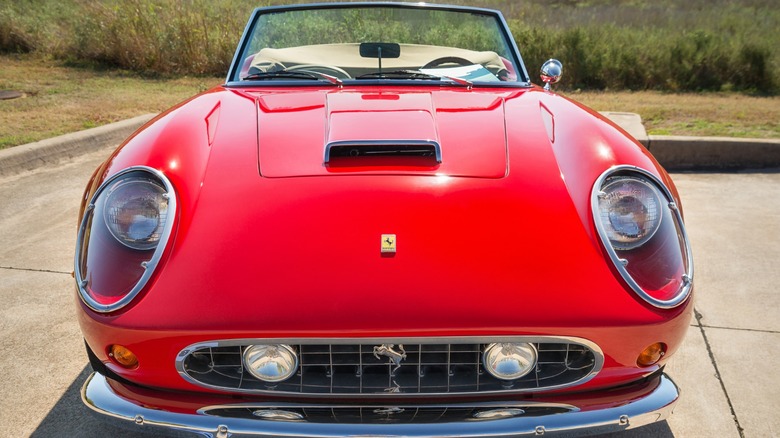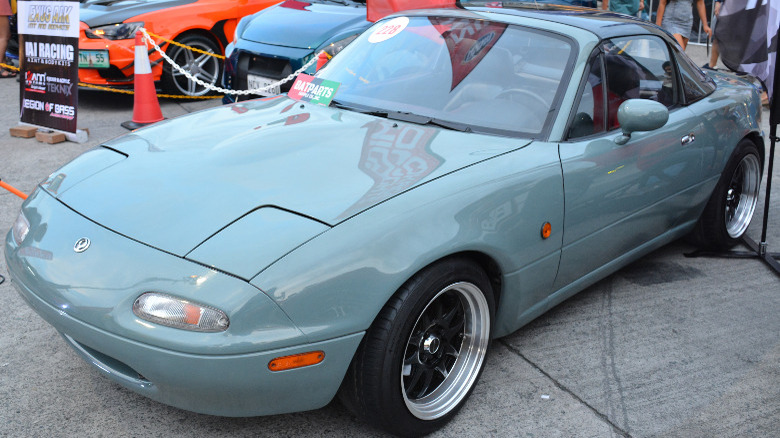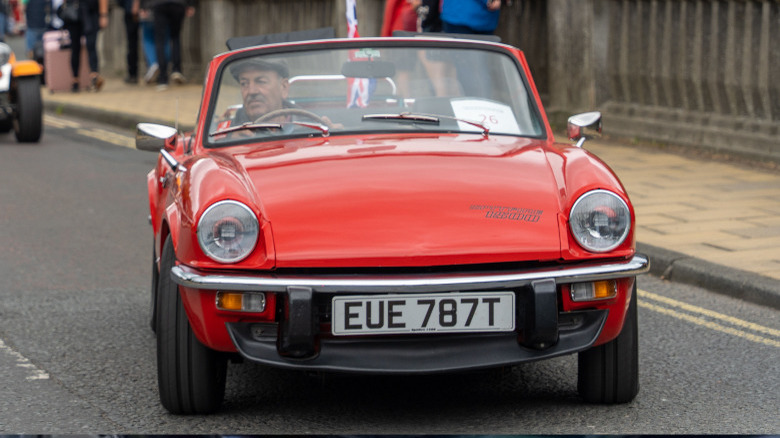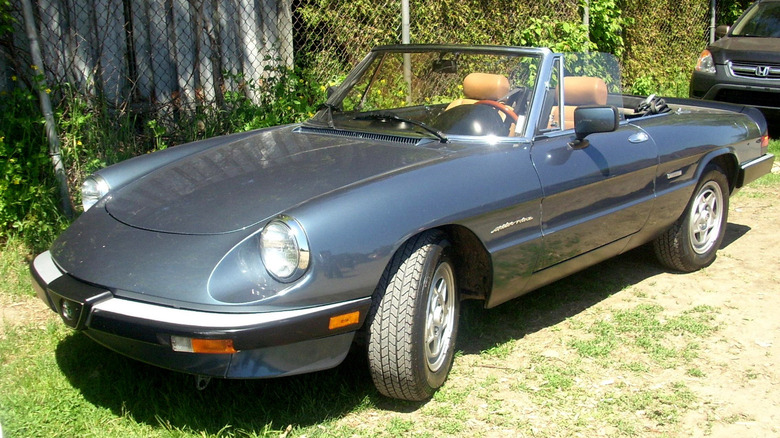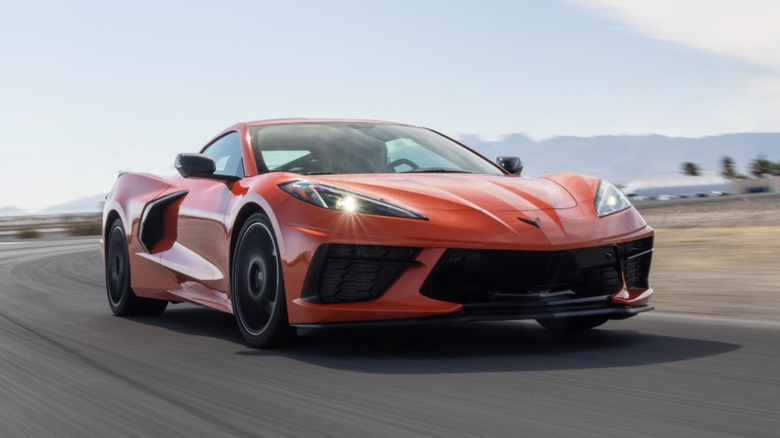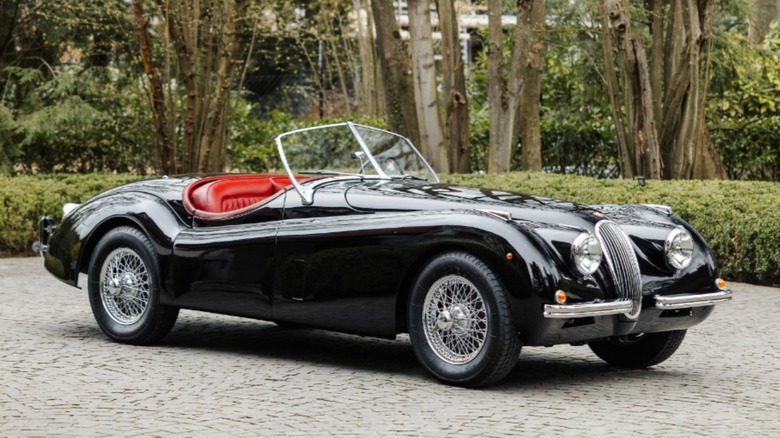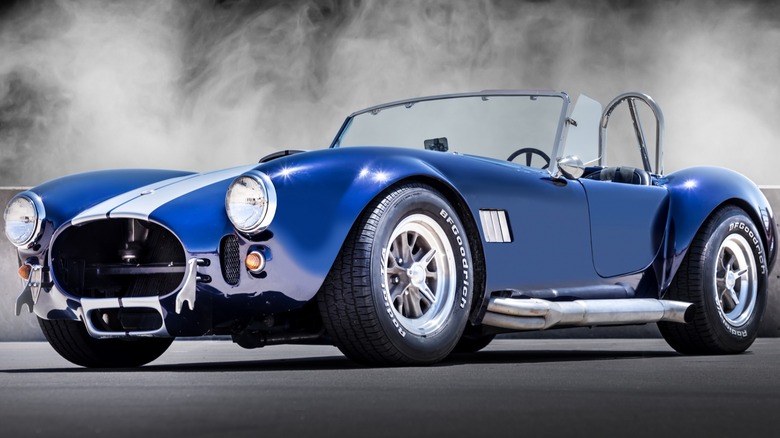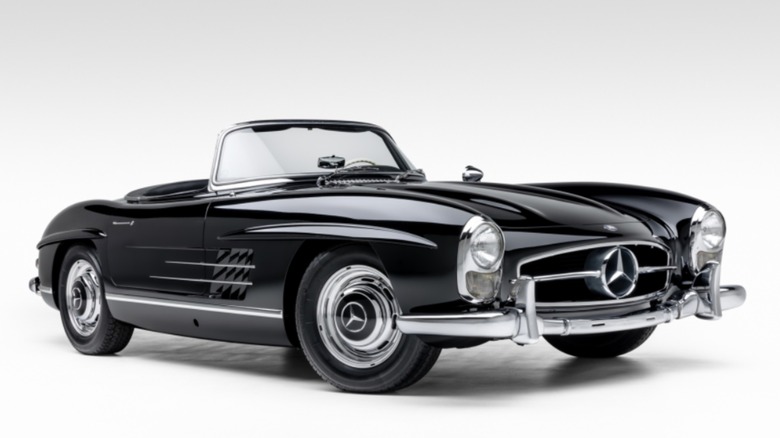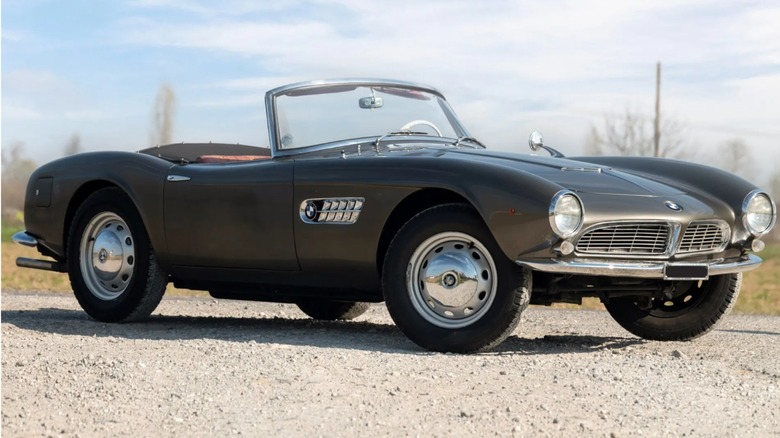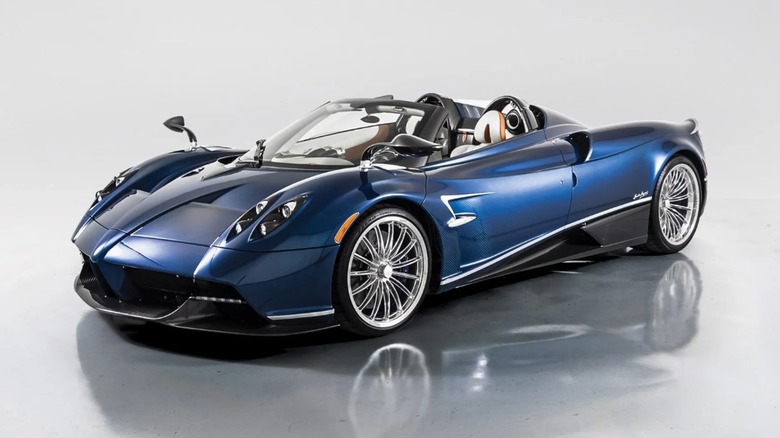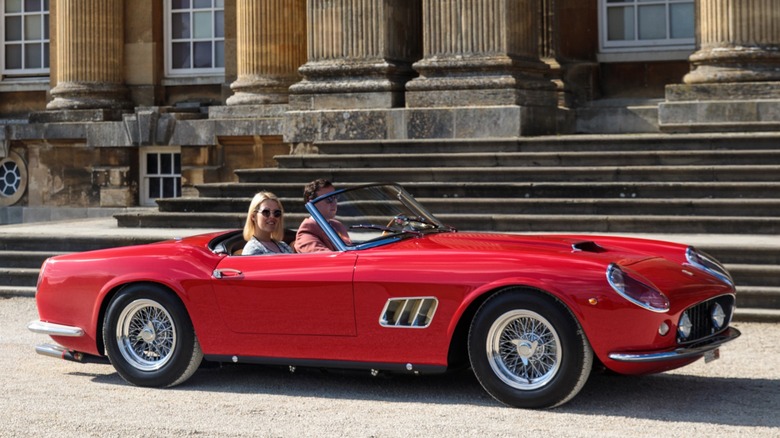10 Of The Coolest Roadsters Ever Made, Ranked By Auction Price
There is no feeling like driving on a sunny day with the wind in your air, or cruising the strip on a warm summer evening with the stars up above. Of course, convertibles are likely the most impractical vehicles on the road, but they are so alluring it does not matter. Even more alluring than a convertible is a true roadster, a two-seater sports car that you can drive with a roof optional. Sometimes roadsters are flashy and expensive, but others are more humble — yet still exhilarating to drive.
The roadster has been a part of the automobile experience from the beginning. As the first cars had no roof at all, introducing one of canvas was a novel idea. Then as hardtop cars came around, many still found the feeling of driving open to the elements enjoyable enough to continue the practice by building cars catering solely to the driving experience. While many roadster models come with the fires of hell rumbling beneath the hood to propel you and your passenger toward the speed of sound in an instant, many offer a milder experience in which flat-out speed is not so important as cornering. Driving a traditional British roadster can be compared to the experience of driving a go-kart. Personal preference aside, it is hard to deny that these are the coolest roadsters ever made. We present these examples, arranged by final bid at auction, starting with the lowest.
1990 Mazda MX-5 Miata - $18,000
British roadsters from the likes of MG and Triumph were incredibly popular for many years through the '60s and '70s, but suffered from declining sales and overseas mismanagement until they became non-existent in American showrooms by the end of the Reagan administration. You might have thought that interest no longer remained for these small and impractical cars; in reality, it was a convergence of different factors that led to the decline in available options. They were also known for being notoriously unreliable. Yet the desire for such roadsters was proven to exist when Mazda released its MX-5 Mista in 1990 and has been selling it ever since.
Mazda rejuvenated the market for roadsters singlehandedly with its small, stylish, and utterly reliable little Miata. It was never a flashy, loud, fast, or obnoxious car, but provided superb handling with perfect 50/50 weight distribution and excellent build quality. Fun driving became fashionable in a Miata, but it also had a second effect on the track. Because of its use in SCCA racing for many years, Mazda claims the title for its MX-5 as the "world's most raced sports car." On any given weekend, thousands of MX-5s can be found at local tracks racing in the SCCA Miata Spec class and other types of racing, such as autocross.
As an affordable car, the debut model remains attainable today. Just a few years ago, Bring a Trailer sold one with just 1,400 miles on it for $18,000, which is a steal compared to new cars today.
1978 Triumph Spitfire 1500 - $20,000
Triumph for many years produced the quintessential British sports car. With a lively but simple 4-cylinder engine and go-kart-like handling due to its position practically resting on the road, the Spitfire 1500 was built for drives through winding country lanes. It was among the last vehicles designed and built by the British company, and 1500 denotes the engine size — 1,500cc, the largest of the Spitfires, which began production in 1962.
Giovanni Michelotti provided the styling of this model, which explains the stunning curves that gave it an overall look not wholly dissimilar to a Ferrari of the same vintage. These are attractive little cars, and the handling is extremely sharp and responsive. While the ride is not very forgiving, the fun driving experience more than makes up for it. However, while the steering is precise and the car stays steady through any curve, the single-leaf swing-axle independent rear suspension can create a harrowing experience under the right conditions.
The interior of a Spitfire is extremely basic and not of the best quality. Cheap materials and what sometimes look like unfinished pieces from the factory often add to the charm, although they can just as easily frustrate. Nonetheless, these are cars built for fun and if you don't take them too seriously, they can be great to own. A recent example with a frame-off restoration sold on Bring a Trailer for $20,000, though less picky buyers can pick them up for far less than that.
1986 Alfa Romeo Spider Veloce - $32,000
The decline of roadsters through the '80s was not absolute. MG, Triumph, and Fiat may have left the market, but Alfa Romeo held on, overlapping in sales with Mazda until 1994 saw the end of all Alfa imports. The Alfa Spider debuted in 1966, continuing in production until 1994.
Styling remained consistent throughout its run, with only mild upgrades and tweaks applied. Engine choices started small, with 1.3-, 1.6-, and 1.8-liter options, but increased to 2.0-liter in the '70s. While carburetors were swapped for SPICA mechanical fuel injection early on, it was in 1982 that a Bosch electronic fuel injection became standard. This is the reason for choosing a later version of the Spider. Some might argue that the early models exemplify the best of its Italian styling and charm, a later version gets you a nearly identical look, with modern creature comforts and reliability. Bosch injection, air conditioning, and modern electronics combine to create a Spider that is much more enjoyable in the long run, making the 1986 Spider Veloce arguably the best of the bunch. Additionally, a rear spoiler was added in the '80s but dropped for the 1990 model year, along with a small part of its charm.
An example of a later Spider in immaculate condition does not come cheap. While you can find some in well-used but drivable shape, a 1986 model sold on Bring a Trailer in late 2023 for $32,000. It only had 25,000 miles and looked like a new car inside and out. This is the ideal specimen for a vintage Alfa Spider.
2020 Chevrolet Corvette - $83,200
A far cry from a vintage British sports car, the 2020 Corvette is a different beast altogether. When this Corvette burst onto the scene in 2019, it turned the world around for car buffs, and Corvette fans in particular. The long-time Chevrolet halo sports car that had been a front-engine and rear-drive sports car had suddenly become more similar to a Lamborghini than a Camaro. The engineers at Chevrolet had considered making it mid-engined but held off for decades to keep from rocking the boat. When they determined the car was at the limits of their engineering possibilities, the boat rocking was inescapable.
The 2020 Corvette immediately attracted a line of buyers when it was announced, although the first-year roll-out was complicated by a pandemic raging around the world. The world finally returned to some sense of normality, and the C8 Corvette proved that the mid-engine design was the right choice. The new Chevrolet C8 Corvette attracted buyers by offering incredible performance from its 495-horsepower V8 engine, excellent balanced handling, and reasonable base price of just $60,000. This was an American roadster with the style and performance of an Italian exotic for a fraction of the cost.
While prices are still nothing like those of exotics, not much depreciation, if any, has yet come to the Corvette. A well-equipped Stingray, the upgraded performance model, on Bring a Trailer with just 13,000 miles and an added ProCharger supercharger sold recently for $83,200, a little over its list price when new.
1952 Jaguar XK120 - $107,139
British carmaker Jaguar is world-renowned for making fine luxury cars with sporting appeal. Ensconcing powerful Jaguar six-cylinder engines in lightweight bodies sculpted by Jaguar designers and completed with fine English leather and woodwork created some of the finest roadsters available in the post-war period. Among the most cherished models of the period is the Jaguar XK120, built from 1949 to 1954.
In a time when many American manufacturers still used flathead engines and many were only just switching to overhead valves, Jaguar was perfecting its twin-overhead-cam 3.4-liter straight-6 and installing it in what was one of the fastest cars of its day, up to a 120 mph top speed, the fastest ever in 1948. The shape of the XK120 when introduced in 1948 immediately garnered the attention of potential buyers, and Jaguar soon had orders building up for what was meant to be a limited-production car. Its gracefully sculpted and lightweight body was enough to draw buyers in, even if the car lacked windows and a roof.
One of the first XK120 models delivered went to none other than Clark Gable. At a price significantly higher than a brand-new Cadillac of its day, the alluring speed of the XK120 was its main draw. Today, they are celebrated icons of the company hailing from a time when Jaguar was rebuilding its way back to prominence. A nice example under the hammer by Bonham's late in 2023 sold for €97,750 (approximately $107,139), which is typical for these cars in perfectly restored condition.
1965 Shelby 427 Cobra - $1.3 million
Any time Carroll Shelby gets involved in a car's development process, amazing things happen. And so it was in the early '60s, when Shelby wanted to build a new car, that he happened upon a boutique British automaker building its AC Ace roadster. With beautifully sculpted lines and excellent handling, the only thing it was missing was a real engine, as the outdated British six-cylinders they were using were woefully underpowered. Shelby had them drop in a new Ford Windsor engine and history was made.
The new Shelby Cobra was a hit, even though production numbers ultimately remained relatively low. The first cars with a 289 Ford V8 proved to be irresistibly fun and fast. They were hopelessly basic cars, lacking windows and a roof, but their curvy bodies and excellent handling made them go around a track like nothing else. Not satisfied with just having a quick and agile car, Shelby made some modifications, such as swapping leaf springs for coils and dropping Ford 427 big-block engines in what was not much bigger than a go-kart, and made a screaming fast car that bordered on the dangerous.
Shelby Cobras production stopped a few cars shy of 1,000. But it did spawn a cottage industry of replica builders making copies of the car at home from kits. The replica business has had such an enduring legacy that Shelby American today offers fully-built Cobras with fiberglass or aluminum shells. While these are not cheap, the price pales in comparison to an original. Mecum sold an original 427 Cobra in 2023 for $1.4 million, although some special model Cobras can go for much more. Carroll Shelby's personal Cobra went for about $5.5 million in a Barrett Jackson auction in 2021.
1958 Mercedes Benz 300SL Roadster - $1.82 million
When Mercedes-Benz released its 300SL in 1953, there was nothing else like it on the market. Most notably, its gullwing doors were (and still are) unique, exotic, and intriguing. But it was in 1957 that Mercedes shed the wings and introduced the car as a roadster, which may not get as much attention but is every bit as great of a car.
The Mercedes-Benz 300SL roadster almost didn't make it. If not for the American importer convincing German management it would sell in the States, it would never have come to be. When these cars arrived, despite having a very high price tag, buyers showed up and bought every one Mercedes could build. What they bought turned out to be more than just a light and fast sports car — it was also practical, comfortable, and extraordinarily reliable. It was the first production car sold with fuel injection — mechanical direct injection to be exact — and that contributed to the robust nature of the car. While vintage Maserati and Ferrari owners have to be extra fussy about tuning and maintenance before a drive, 300 owners just need their keys.
Buyers of the 300SL not only got excellent driving cars; they made extraordinary investments. With a continued upward trajectory in value, today's cars sell for more than a million dollars. A model sold with RM Sotheby's in January of 2023 for $1.82 million.
1957 BMW 507 - $2.2 million
It is a shame that the BMW 507 roadster of the '50s failed to garner sufficient sales to justify its continued production, because it is a stunningly beautiful car and one of the finest (inorganic) shapes of the era. The car launched in 1955 after being produced at the urging of BMW's American importer, who was confident sales would materialize as soon as it became available. It was meant to be a premium mid-priced sports car that ended up not working in the real world as it had on paper.
BMW had already produced a new luxury sedan with a new V8 engine, and that was chosen for the new roadster. The body was built by hand out of aluminum, which should have lightened up the car well enough to provide good acceleration from the 150-horsepower overhead-valve 3.2-liter V8. The cars did come with a convertible ragtop, although a small number of customers also ordered a detachable hardtop with their cars. The 507 also benefited from excellent handling, thanks to its double wishbone suspension and front anti-roll bar suspended by front and rear torsion bars.
The target retail price was $5,000, which was not cheap for the era but it was reasonable for an exclusive car. When the cars finally went on sale, production costs had pushed the price up to $10,500, nearly three times that of a Cadillac. However, that could have been a good investment, considering these rare specimens can sell for a significant sum, such as one from R.M. Sotheby's in 2022 in Monaco that ended bidding at €2,030,000 (approximately $2.2 million).
2020 Pagani Huayra Roadster - $2.3 million
Horacio Pagani established himself as a designer of exotic cars with Lamborghini, but when he suggested the company needed to get an autoclave for making parts from carbon fiber, he was rebuffed by the higher-ups. Undeterred in his quest to use the new material, Pagani instead set out to create his own cars, which he did oh so well.
The Pagani Huayra is the second car to come from Pagani Automobili. It is a perfect blend of form and function, displaying the best of both in a symphony of carbon fiber, leather, and premium alloys. Though the cars are designed and built by Pagani, the engines are supplied by AMG, the high-performance division of Mercedes-Benz. The engines are bespoke and engineered specifically for the Huayra and provide up to 750 horsepower to push the car of just under 3,000 pounds to excessive speed. Inside a Huayra you will find carbon fiber and titanium complemented by supple Italian leather in one of the most strikingly beautiful automotive interiors ever made. Coupled with the work of art that makes up the exterior, each bespoke-built Huayra is an exclusive gem.
A car as complex, unique, and powerful as a Huayra does not come cheap. With only a handful of cars built each year, they do not come up for auction all too often. However, a 2018 Huayra Roadster was sold in 2020 by R.M. Sotheby's for $2.3 million, and that is probably at the low end of today's values.
1962 Ferrari 250 GT SWB California Spider - $18 million
There is perhaps no name in the world of sports cars with such prestige and cachet as Ferrari. While it is a maker of some of the finest cars in the world today, its history is that of a world-class automaker from the start. Furthermore, Enzo Ferrari's foray into production car manufacturing began with a few limited-production models. It had expanded by the '60s, producing exotic grand touring cars and roadsters for those who could afford the finest things in life.
With its 3.0-liter Colombo V12 engine fed by a trio of Weber carburetors, the Ferrari 250 GT SWB California Spider is about the coolest car on the planet. There are others today that are far more powerful, but few so beautiful and elegant. This model was styled by Scaglietti, who authored the lithe roadster with sumptuous curves that have aged gracefully. Every detail of the car is a work of art, from the leather-clad interior to the valve covers with the triple-carburetor intake wedged between. By today's standards, it is a simple car with few amenities, but it is in the driving experience that it shines.
While Ferrari production had ramped up markedly from its 1940s origins, the total production number of this roadster barely surpassed 50. It is a rare car that is valued so extraordinarily highly by collectors. Of the cars produced, 37 feature enclosed headlights, the most prized model; the most recent auction of one from Gooding & Company, with a bid of $18 million, happened in 2023.
